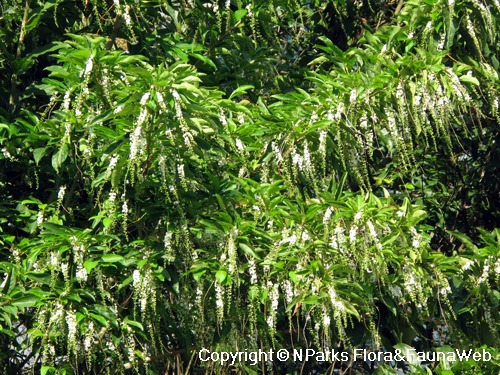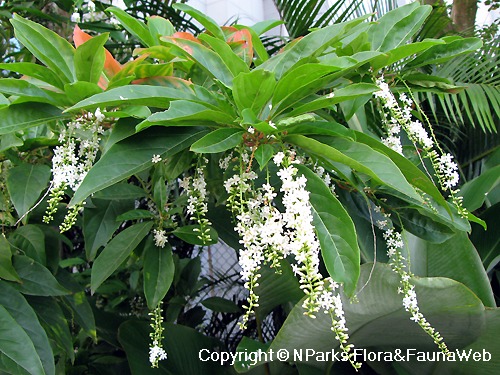
Back
Citharexylum spinosum L.
| Family Name: | Verbenaceae |
| Synonyms: | Citharexylum quadrangulare |
| Common Name: | Fiddlewood, 提琴木 |
Name
Classifications and Characteristics
| Plant Division | Angiosperms (Flowering Seed Plants) (Dicotyledon) |
|---|---|
| Plant Growth Form | Tree (Small (6m-15m)) |
| Lifespan (in Singapore) | Perennial |
| Mode of Nutrition | Autotrophic |
| Maximum Height | 10 m to 12 m |
| Maximum Plant Spread / Crown Width | 6 m |
Biogeography
| Native Distribution | West Indies |
|---|---|
| Preferred Climate Zone | Tropical |
Description and Ethnobotany
| Others - Plant Morphology | Small and dioecious evergreen tree, deciduous in countries with cooler climate. Leaves up to 20 cm by 10 cm, attached to orange-yellow petioles, green but turns orange when aged and drop off. Branches generally tetragonal, giving rise to synonym species epithet ‘quadrangulare’. Flowers unisexual, up to 30cm long in racemes, usually terminal and drooping. Fruits globose - shaped, red or orange when immature, turns black when ripe. Often grown for aesthetic purposes due to orangey appearance when leaves age. Fragrant flowers and fast growing also make it popular as a roadside tree. Genus name ‘Citharexylum’ originated from Greek kithara and xylon, meaning lyre or fiddle and wood respectively. Common name fiddlewood derived from the use of the wood for musical instruments. |
|---|---|
| Ethnobotanical Uses | Others: Fiddlewood used to make sounding boards for musical instruments and cabinets. |
Landscaping Features
| Desirable Plant Features | Fragrant (Flowers) (Day) |
|---|---|
| Landscape Uses | Suitable for Roadsides, General, Coastal |
| Thematic Landscaping | Fragrant / Aromatherapy Garden |
| Usage Hazard - Cons | Toxic Upon Ingestion, Invasive / Potentially Invasive |
| Plant & Rootzone Preference or Tolerance Remarks | Prefers soil enriched in organic matter. |
Fauna, Pollination and Dispersal
| Fauna Pollination Dispersal Associated Fauna | Bird-Attracting, Bee-Attracting |
|---|---|
| Seed or Spore Dispersal | Biotic (Fauna) |
Plant Care and Propagation
| Light Preference | Full Sun |
|---|---|
| Water Preference | Moderate Water |
| Plant Growth Rate | Fast to Moderate |
| Rootzone Tolerance | Well-Drained Soils |
| Maintenance Requirements | Low |
| Propagation Method | Seed, Stem Cutting |
Foliar
| Foliage Retention | Evergreen |
|---|---|
| Mature Foliage Colour(s) | Green, Orange |
| Foliar Type | Simple / Unifoliate |
| Foliar Shape(s) | Non-Palm Foliage (Elliptical) |
| Foliar Venation | Pinnate / Net |
| Foliar Margin | Entire |
| Typical Foliar Area | Macrophyll ( 182.25cm2 - 1640.25 cm2 ) |
| Leaf Area Index (LAI) for Green Plot Ratio | 3.0 (Tree - Intermediate Canopy) |
Non - Foliar and Storage
| Trunk Type (Non Palm) | Woody |
|---|---|
| Mature Bark Texture | Fissured |
| Stem Type & Modification | Woody |
Floral (Angiosperm)
| Flower & Plant Sexuality | Unisexual Flowers , Dioecious |
| Flower Colour(s) | White |
|---|
| Inflorescence Type | Raceme |
| Flowering Habit | Polycarpic |
Fruit, Seed and Spore
| Mature Fruit Colour(s) | Black |
|---|
Image Repository
Others
| Master ID | 1515 |
|---|---|
| Species ID | 2808 |
| Flora Disclaimer | The information in this website has been compiled from reliable sources, such as reference works on medicinal plants. It is not a substitute for medical advice or treatment and NParks does not purport to provide any medical advice. Readers should always consult his/her physician before using or consuming a plant for medicinal purposes. |








